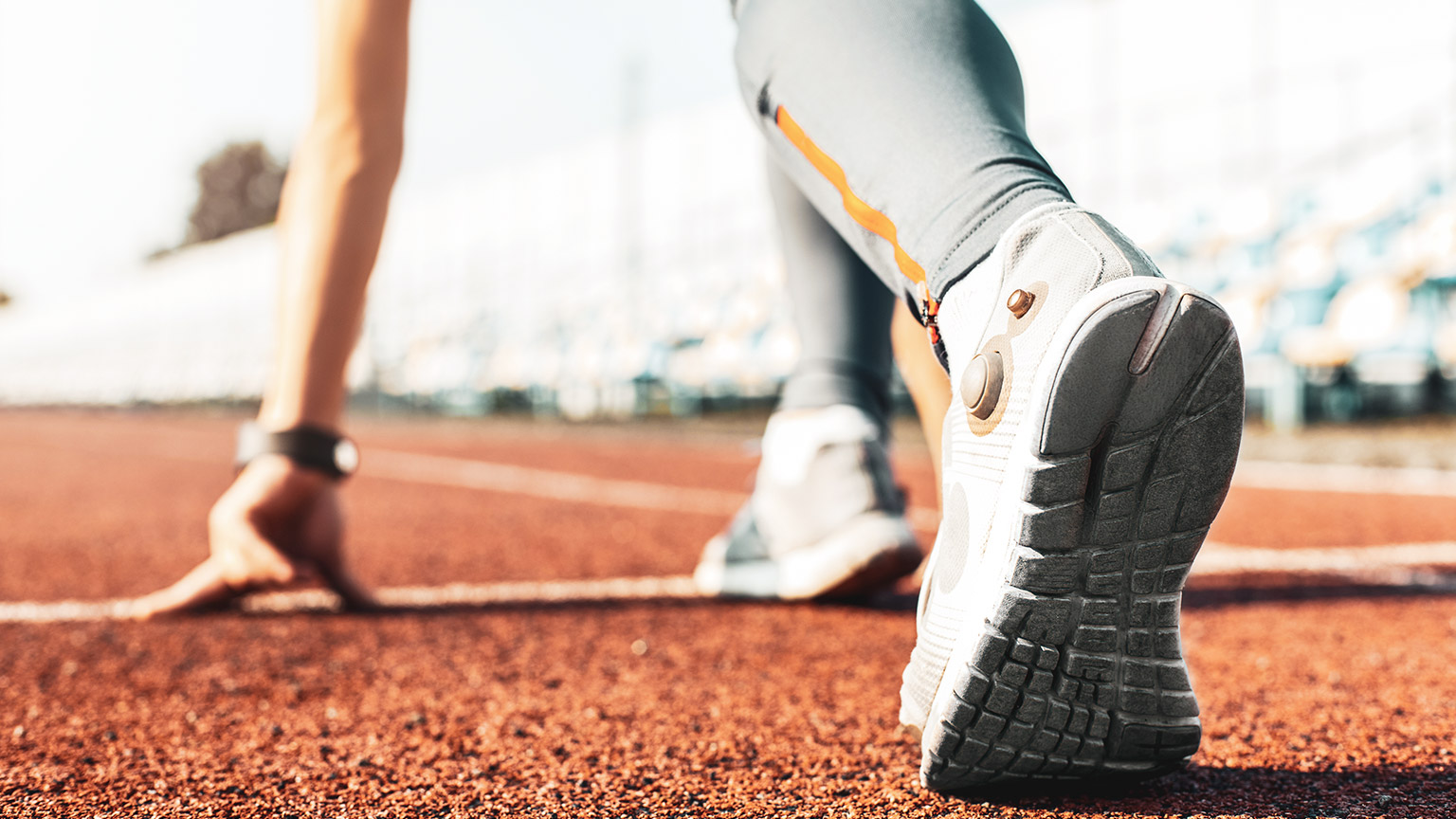Fitness components are ways of identifying a person's fitness. How fast is your client? How agile? How powerful?
Understanding components allows you to analyse your client's fitness, and accurately prescribe ideal sets, reps, and rests to meet fitness goals. For example, suppose a netball player wants to improve their speed and agility to intercept more often and regain possession. In that case, you'd look to develop their speed, agility, and quickness (reflexive reactions).
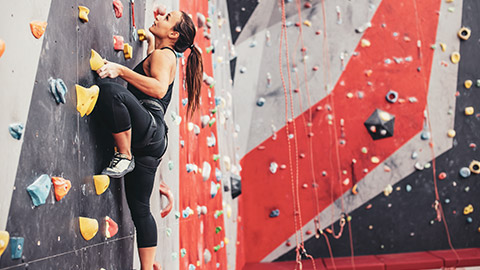
What does it mean to be physically "fit"?
Hopefully, as you've reflected on what "fitness" means to you, you will have realised there is a lot of nuance and complexity in how you answer this question. It is an impossible task to decide if a marathon runner is fitter than a shot-putter. Each athlete excels at different fitness components at opposite ends of the spectrum. One way you could answer this question is by looking at all the components that go together to define fitness.
Fitness is the ability to make enough energy to meet the demands being placed on the body. It is the body's ability to produce ATP, the fuel for muscle contraction, and is essential for survival. This is a key part of your learning.
Components of Fitness: Categories
The components of fitness can be split into 2 key areas; health-related components and skill/performance-related components.
Health-related components can be incorporated into everyday activities. They are lifetime activities, and components in this group help to reduce chronic disease and improve health. Skill-related components relate to physical performance and help with sports and motor skills.
Let’s start with general physical fitness for health and a baseline for most sports. Being physically fit is about balancing the different components. For general health and fitness at any age, we want to be competent in all these components.
- Cardiovascular endurance
- Muscular endurance
- Muscular strength
- Flexibility
- Body composition
We can also consider skill-related fitness components.
- Speed
- Power
- Agility
- Balance
- Coordination
- Reaction time
A good balance in all of these areas won’t just make you a valuable team member for your chosen sport, you will also reap the benefits of having a healthy heart and set of lungs, good muscle development and body composition, and be less likely to get injured from lack of mobility and flexibility.
If we could give every individual the right amount of nourishment and exercise, not too little and not too much, we would have found the safest way to health.Hippocrates
In this topic, you will learn about:
- Health-related fitness components
- Skill-related fitness components
- Anaerobic and aerobic components
We'll finish this topic by discussing what fitness components you think are most important for various sports.
Let's take a closer look at how health-related components are defined, and what benefits they offer.
Cardiovascular endurance
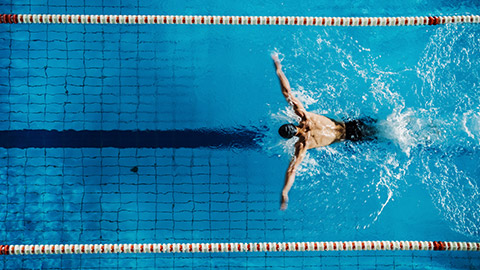
Cardiovascular endurance (also known as cardiorespiratory endurance or aerobic fitness) refers to your body's ability to efficiently and effectively intake oxygen and deliver it to your body's tissues by way of the heart, lungs, arteries, vessels, and veins.
By engaging in a regular cardiorespiratory exercise like cycling, hill walking, and running, you can:
- maintain or even improve the efficient delivery and uptake of oxygen to your body's systems.
- enhance cellular metabolism.
- ease the physical challenges of everyday life.
Muscular endurance
Muscular endurance is your muscle's ability to exert force (contract) repeatedly or for an extended period of time. It could be considered the pinnacle of fitness as it is combined muscular strength, cardio endurance, components of mobility/flexibility, and most people with high muscular endurance will have favourable body compositions, (i.e., healthy body fat levels and substantial muscle mass).
Answer the questions, and expand the accordions to see an example answer when ready.
- What is an example of a sport where the athletes have to perform feats of muscular endurance?
- What gym exercises can be performed with improved muscular endurance?
Long-distance cyclists
To continuously pedal a bike over a long distance, often up steep inclines, cyclists have to develop fatigue-resistant muscles in their legs and glutes. These are evidence of a high level of muscular endurance.
Planks
Holding a plank to develop core strength is another example of muscular endurance. The longer you can contract your abdominals and hold your body in a steady position, the greater endurance you have through your hips, abdominals, and shoulders.
Watch
The following video demonstrates a sit-up test, one way to test muscular endurance.
Muscular strength
While muscular endurance refers to how fatigue-resistant a particular muscle group is, muscular strength refers to the amount of force a particular muscle group can produce in one, all-out effort. A key measure of strength in the gym is a one-rep max.
Why do people train for strength?
- Weightlifting and powerlifting competitions
- Bodybuilding to maximise muscular development for aesthetic goals
- General strength training for fitness and health enhancement
- Physical therapy for rehab from injury or disease
- Sport-specific training for position-specific strength
- Fall-prevention
Factors such as neural activation, muscle fibre type and size, and limb length affect the capability of the muscle to produce force. To read more about these factors, expand the accordions.
Much of the power called up in muscles is due to how the nervous system controls how hard muscles pull. This is called neural activation and improvements are seen rapidly once training starts. Learning to lift weights is the same process as learning to ride a bike as a child.
Muscles are made up of 3 fibre types, slow-twitch and fast-twitch fibres (types a and b). Fast-twitch are well adapted to using anaerobic energy systems meaning they can pull very hard and produce more force. Someone with more fast-twitch fibres will generally be stronger than someone with more slow-twitch fibres.
Cross-section area size or muscle girth matters with muscles. The wider the muscle the more fibres are in line to pull hard.
Limbs or long bones act as levers and depending on their length, you get some biomechanical advantages for lifting heavy weights.
The following graph illustrates how neural activation, muscle fibre type and size, and limb length affect strength.
This graph demonstrates how initial rapid gains in strength are brought about mainly by improved neural activation. Muscle growth occurs much later, and strength improves further.
Take care!
Before embarking on a strength goal, we must establish a baseline for strength. In trained athletes with good movement patterns, this will likely be a 1 rep max test. For beginners, this is not really safe so we might look at a 3-rep max or 5-rep max.
However, there is a large learning component to strength training. Beginners will have to work through a process of neuromuscular improvement. This should be done at lighter weights. Trying to progress to strength lifting protocols too early could result in injury.

Flexibility
Flexibility refers to the range of motion you have around a given joint. It is your muscles' and joints' ability to move through their full range of motion (ROM). Like muscular strength and endurance, flexibility is joint-specific. E.g., you may have very flexible shoulders, but tight and inflexible hamstrings or hips.
The following image shows the range of movement (flexibility) in an elbow joint, ranging from 10 degrees or less (hyperextension) to 140 degrees.

Why should we stretch?
According to the American Council on Exercise, the benefits of stretching include:
- Increased Flexibility and ROM
- Improved Circulation
- Better posture
- Stress relief
- Enhanced Performance
Who is flexibility important for?
Flexibility is important at any age. It plays a role in unhindered movement and can affect your balance, coordination, and agility. Maintaining a full range of motion through your major joints can reduce the likelihood of injury and enhance athletic performance.
As you get older, the importance of flexibility becomes even clearer. Think of individuals who are elderly. Many may walk with a shuffle or have difficulty reaching their arms over their heads. This may affect their quality of life, making it more challenging to perform activities of daily living, such as reaching items on high shelves, picking up items off the floor, or simply moving effectively to catch their balance if they start to fall.
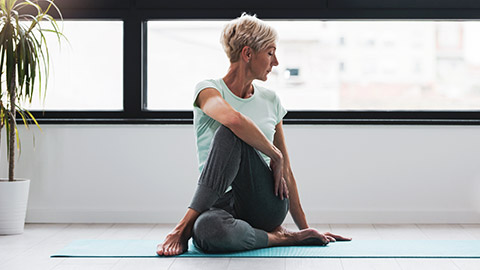
How can we train flexibility?
There are many simple ways to work flexibility into your daily routine. Some of the most common forms of flexibility exercises:
- Static stretching - Where you hold a stretch for 30 or more seconds at a time
- Workouts that take you through dynamic stretching such as Barre, Yoga, Tai Chi, and Pilates
- PNF stretching - The contract-relax stretch where you maintain a static stretch position and subsequently contract against a person or object and then relax to increase ROM
Types of stretching
Static stretching should be performed after working out. If you did a lower body workout, it’d be a good idea to spend 30 seconds on each leg for your hamstrings, quads, glutes, lower back, and calves. For the upper body try stretches that focus on lats, pecs, shoulders, biceps and triceps, and traps.
Dynamic stretching involves activities such as typical warm-ups like leg swings, hippy squats, and low Cossack squats as well as full sessions such as yoga. Check out Yoga with Adriene on Youtube for many yoga videos for beginners to advanced.
PNF stretching is proprioceptive neuromuscular facilitation, basically stretching in a way that allows your brain to work with your muscles to recognise the stretching process and relax further and deeper into the stretch.
Watch
In this video, you can see an example of a PNF stretch for the hamstring.
Body composition
Body composition is your body's ratio of lean muscle to stored fat. To see improvements in body composition, you need to know what your starting point is. Weighing yourself on a scale won't do the trick, as weight alone tells you nothing about the makeup of your internal tissues.
There are several ways that you can measure body composition including:
- Skin fold testing
- Bioelectrical impedance analysis (BIA)
- Hydrostatic testing - This is considered the gold standard and involves being weighed on dry land followed by being weighed underwater since fat weighs less than lean tissue
- DEXA (Dual-energy X-ray absorptiometry) scans
Improving body composition is a combination of diet and exercise. From an exercise perspective, a mix of cardio and resistance training appears to be the most effective. The cardio targets fat burning and resistance training builds muscle tissue which increases your basal metabolic rate (i.e. body burns more calories at rest).
Skill-related fitness components are movements that are required for a person to successfully demonstrate a variety of motor skills and movement patterns. There are 6 skill-related fitness components.
| Speed | The ability to perform actions or cover distance quickly. |
|---|---|
| Power | The ability to combine both speed and force in movements and actions. |
| Agility | The ability to quickly change direction without losing speed or power. |
| Balance | The ability to stabilise the body both in movement and when maintaining stillness. |
| Coordination | The ability to use your senses in combination with your actions when in movement. |
| Reaction time (Quickness) | The ability to respond quickly to what you feel, see or hear. |
SAQ training
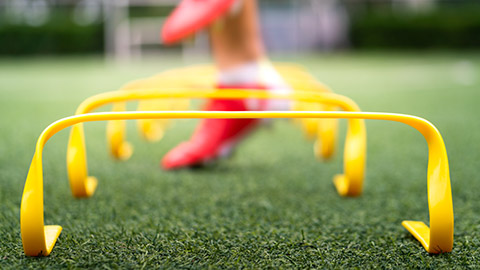
3 of these components go hand-in-hand and are important for successful performance in sports:
- Speed
- Agility
- Quickness
Often these components are worked together. Speed, agility, and quickness (SAQ) are all related, but refer to different skills that make someone fast.
- Speed is moving as fast as possible, in a straight line, from point A to B. This is sometimes called linear speed.
- Agility is the ability to change directions quickly and efficiently. It also includes deceleration.
- Quickness is associated with a fast reaction time and processing information rapidly (reflexive reactions).
Some sports will require more of one than the other, so you must consider this when completing sporting needs analysis. E.g., a 100m sprint athlete would only need to develop speed and quickness (reaction time to a starting gun stimulus).
Speed
Speed is the capacity to move or travel quickly over a given distance. Mechanically, it means the ratio between distance and time, shown by the formula:
Speed = distance / time
Speed involves a lot of specialist skill, drill, and technique-based training. Before a client can improve their speed it is important to consider the other components of fitness which are 'prerequisite' training blocks for developing speed. These training blocks are:
- basic aerobic and muscle endurance
- strength
- power
Watch
Think about speed ability as you watch a re-run of one of Usain Bolt’s world records. The short video explains the science behind sprint running and the magic of Usain Bolt's use of power.
Developing speed
Developing speed is a combination of improving 2 qualities - stride length and stride frequency.
Speed = stride length x stride frequency
Good training will seek to improve both factors as much as possible.
Agility: Multidirectional speed
Agility is the ability to start, stop, and move the body in all directions quickly. It is a combination of speed, power, balance, and coordination to change the direction of speed. The goal here is to take the basic straight-line speed that has been developed in your first phase of training and transfer it into a more specific multidirectional and agility-based speed.
Multidirectional speed/agility is a series of complex movements in the context of a specific game. It can be planned or reactive. It is an integral skill for most sports. The components of multidirectional speed:
- Recognition and reaction
- Starting and first step
- Acceleration
- Footwork
- Change of direction
- Stopping
Speed and agility guidelines
This table outlines guidelines for speed and agility training.
| Intensity | 95 – 100% of max effort – ATP-PC system. Note that there are speed training methods that stimulate you to exceed 100% of max effort, known as ‘assisted’ training such as slingshot training with bungee. |
|---|---|
| Timeframe of efforts | 2 – 10 seconds in duration – ATP-PC system. |
| Rest periods | 1 – 3 minutes depending on the length of the sprint. |
| Reps or volume | 4 – 10 reps. The volume of training will generally be low, with a focus on quality over quantity. |
| Type | Speed training can be anything specific to the goals but generally sprint speed. Agility will involve drills around a predetermined course. |
Watch
This video provides an impressive demonstration of agility combined with speed to a degree beyond what could be achieved by a person.
Reaction time
Reaction time (or response time) refers to the amount of time that takes place between when we perceive something, to when we respond to it. It is the ability to detect, process, and respond to a stimulus. Reaction time can be expressed as a process:
- Stimulus presented
- Stimulus received
- Nervous system responds
- Muscle action produced
The following illustration breaks down the time in milliseconds (ms) of a batter hitting a ball. It starts from the time the light from the ball reaches the eye (0 ms), the time a baseball batter sees a ball (50 ms) to the decision to swing the bat (125 ms) to the time the bat crosses the plate (300 ms).
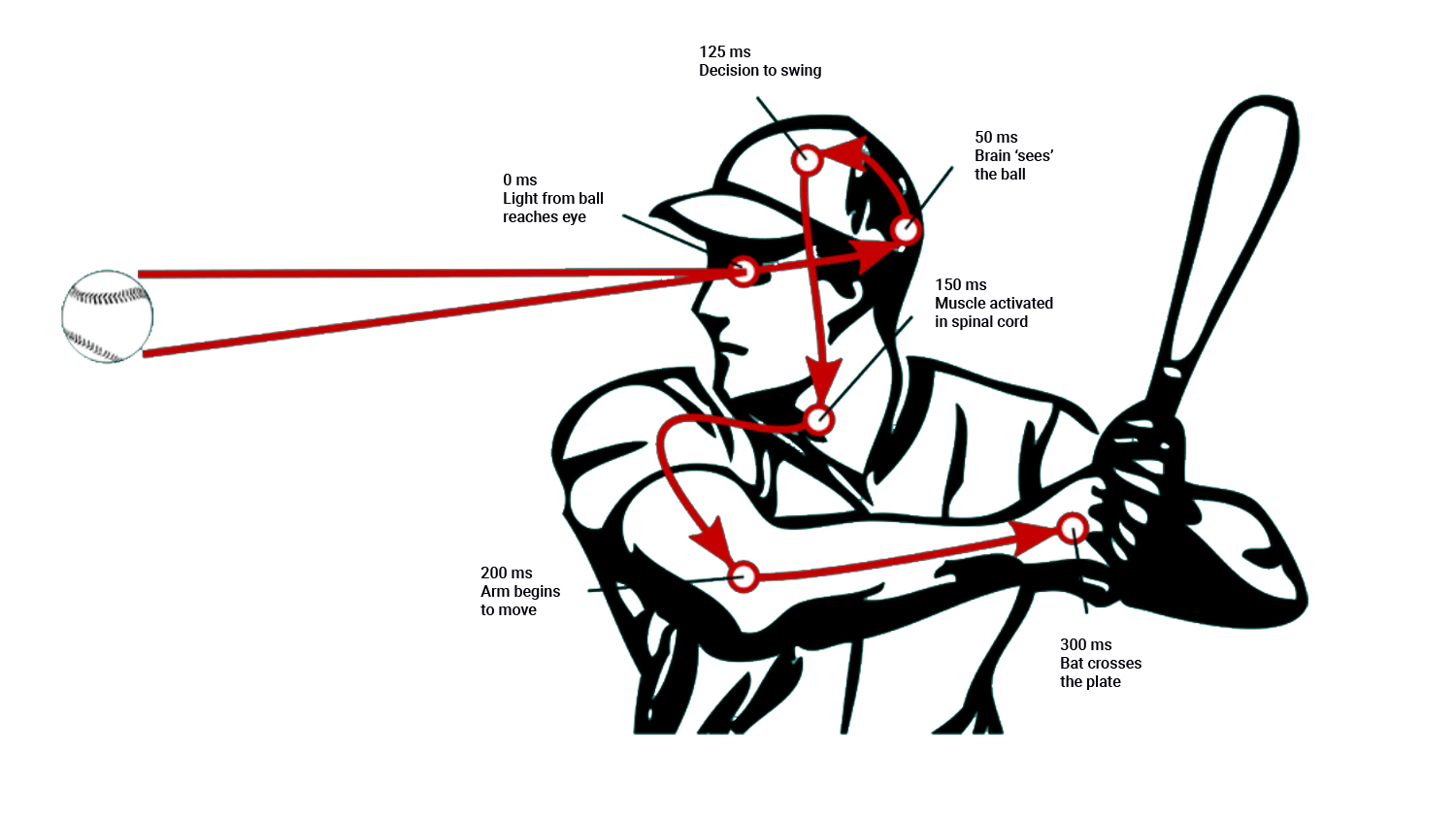
Watch
The following video explains the importance of reaction time for professional baseball players and how hand/eye progression can be developed.
Reaction time can be the difference between success and failure at the highest level. It can give split-second advantages for athletes over their opponents, which can be the difference between winning and losing. In sports, the stimulus you need to react to is usually either visual (e.g. catching a ball), auditory (e.g. reacting to a gun in a sprint race), or via touch (e.g. the feel of your opponent making a grab in Judo).

Issues with reaction time can have their root cause in several areas:
- Issues with perception, i.e., picking up the stimulus. This could be due to vision/hearing issues, or a lack of ability to focus (block out distraction).
- Issues with processing, i.e., the ability to determine what you are experiencing and decide on the appropriate response. This can be practised and honed.
- Issues with response. This could relate to muscle fibre types.
The key to fast reaction time lies mainly with the nervous system.
Try it out - "the ruler test"
The ruler test gives an indication of reaction time. You will need to find one other person to do this exercise with. One person will hold a ruler and drop it. The other person will catch the ruler.
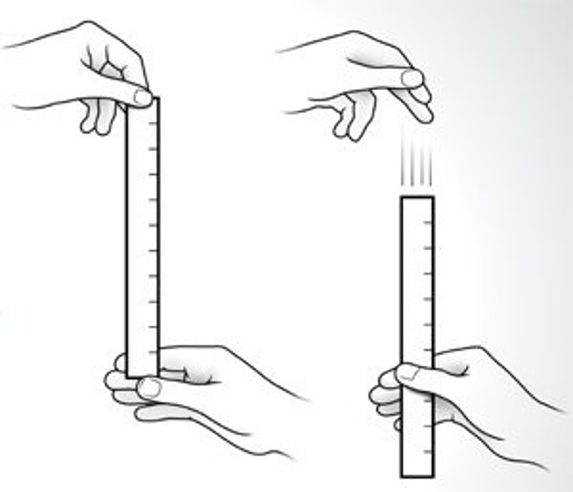
Equipment:
- A 30cm ruler (you can use a shorter ruler, but you'll have to react faster!)
Instructions:
- Sit, or stand, with your arm outstretched in front of you and your thumb and first finger in a pincer grip position.
- Your partner holds the ruler from the 30cm end, and positions the 0cm end just above the gap between your thumb and finger. You should not touch the ruler.
- Without warning, your partner drops the ruler and you catch the ruler as quickly as you can. Use only your thumb and finger.
- Record the point, to the nearest cm, you caught the ruler.
- You have 3 attempts. Record your best (shortest) measurement.
Next:
- Try your non-dominant hand.
- Try closing your eyes and responding to audio prompts “now!”
- Does your reaction time get better with practice?
Power
If strength is the ability to move an object, power reflects how quickly you can exert force.
Power = force x acceleration
Many sports require power to shift an opponent, smack a ball a long way or quickly (cricket, golf, hockey), or propel your body along, up or out (sprinting, long/high jump).
Balance and stability
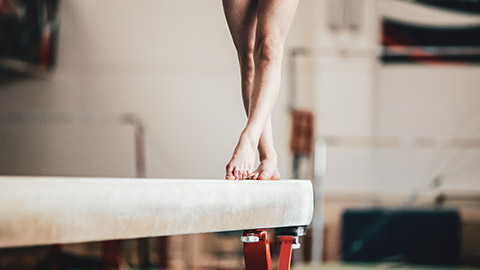
Balance and stability are important components of many sports. Obviously, more important for some sports than others, e.g. gymnastics.
- Stability is the ability to maintain the body's centre of gravity over its base of support.
- Balance is the ability to return to a desired position or trajectory following a disturbance.
For any sport, the optimal method to improve balance, proprioception, and core stability is to practice the skill itself on the same surface on which the skill will be performed during competition.
Coordination
Coordination is the body's ability to perform smooth and efficient movements. Good coordination requires the athlete to combine multiple movements into a single movement that is fluid and achieves the intended goal.
Coordination encompasses a multitude of things in sports, e.g.:
- the ability to track and respond efficiently to a moving target (e.g. hitting a baseball).
- the sequencing of muscle activity to groove a movement (golf swing/basketball jump shot).
- the efficiency of repetitive movements (running/cycling/rowing).
Fitness components can also be classified as per their oxygen requirements, as either aerobic (requires oxygen) or anaerobic (energy production in the absence of oxygen).
- Aerobic capacity
- Muscular endurance
- Strength
- Muscular power
- Anerobic power/capacity
Aerobic capacity
Aerobic capacity is the maximum amount of physiological work an individual can do when measured by oxygen consumption and use. This is the volume of oxygen you can consume and use while exercising at your maximum capacity. VO2 max is the maximum amount of oxygen in millilitres, that one can use in one minute per kilogram of body weight (ml/kg/min).
How do you train for it?
Aerobic training methods will develop a client's aerobic capacity.
The following table shows the norms for aerobic capacities (for example, low, good, athletic Olympic) for women and men across different age groups.
| Women | Low | Fair | Avg | Good | High | Athletic | Olympic |
|---|---|---|---|---|---|---|---|
| 20-29 | <28 | 29-34 | 35-43 | 44-48 | 49-53 | 54-59 | 60+ |
| 30-39 | <27 | 28-33 | 34-41 | 42-47 | 48-52 | 53-58 | 59+ |
| 40-49 | <25 | 26-31 | 32-40 | 41-45 | 46-50 | 51-56 | 57+ |
| 50-65 | <21 | 22-28 | 29-36 | 37-41 | 42-45 | 46-49 | 50+ |
| Men | Low | Fair | Avg | Good | High | Athletic | Olympic |
|---|---|---|---|---|---|---|---|
| 20-29 | <38 | 39-43 | 44-51 | 52-56 | 57-62 | 63-69 | 70+ |
| 30-39 | <34 | 35-39 | 40-47 | 48-51 | 52-57 | 58-64 | 65+ |
| 40-49 | <30 | 31-35 | 36-43 | 44-47 | 48-53 | 54-60 | 61+ |
| 50-59 | <25 | 26-31 | 32-39 | 40-43 | 44-48 | 49-55 | 56+ |
| 60-69 | <21 | 22-26 | 27-35 | 36-39 | 40-44 | 45-49 | 50+ |
Watch
Watch the following video to learn more about the V02 max test and benchmarks for physical performance.
Anaerobic capacity
Anaerobic capacity is the ability of the body to produce energy in the absence of or without oxygen. It is the maximal amount of ATP re-synthesized via anaerobic metabolism during short-duration maximal anaerobic exercise. If you recall energy systems, the body has 3 ways of creating ATP; ATP-PC, glycolysis, and oxidative (aerobic) (Green, S Dawson B, 1993). So when we are talking about anaerobic capacity, we are referring to the capacity of 2 of these energy systems (ATP-PC and glycolysis).
How do you train anaerobic capacity?
Anaerobic capacity is developed through anaerobic training methods where maximal power (work per unit time) is developed during all-out, short-term physical effort. It reflects the energy-output capacity of intramuscular high-energy phosphates (ATP and PCr).
Watch
Watch the following video of the world’s fastest stair run to get an idea of what can be achieved through superior anaerobic capacity and power! The video demonstrates perfectly an example of anaerobic capacity. This individual is sprinting maximally up an incline for approximately 60 seconds. His anaerobic power (ATP-PC system) carried him up for the first 10 seconds, and then his anaerobic capacity (glycolytic system) took him to the top.
After watching this video, do you think this individual has low, normal, moderate, or very high blood lactate?
What is anaerobic power?
Anaerobic power is the ability of the body to use the ATP-PC and lactic energy systems (anaerobic glycolysis). It is the maximum amount of energy that can be generated by anaerobic energy systems. You use anaerobic training methods to train it.
Muscular power
Power is also defined as the ability to exert maximum force in the shortest time. Watch the following video of Aleksey Lovchev’s 264 kg world record for a perfect example of muscular power (ATP-PC system).
These next 2 videos are long-form tutorial videos. Ben, from NZIS Wellington will take you through the components of fitness in 2 parts. Each video is about 9 - 14 minutes long. Take notes, and pause if you need to. The information in these videos will help you with your Exercise Prescription assessment and future programme design.
We have now covered the health- and skill-related components of fitness for successful sports performance. Different sports will require a different emphasis on the skills that are most important for high-level performance. What are your thoughts regarding this in relation to various sports?
Choose 3 sports from the list. Rank the 5 most important health- and skill-related components of fitness for your chosen sports. Justify your answers.
- Sprint kayaking
- Field hockey
- Basketball
- Shotput
- Windsurfing
- CrossFit
- Baseball
Post your response in the forum. Read and respond to your peers. Go beyond "I agree/disagree". By providing specific points of agreement or disagreement, you will further the conversation and deepen your learning. Here are some sentence starters to help:
- I agree. Your comment made me think about...
- Can you clarify...?
- Have you considered...?
- That is an interesting idea. I wonder if...
- You make a good point. I would add...
- I respectfully disagree... because...
Perhaps you can share a personal experience that connects to the conversation, or outside resources such as a video, website, article, or image. Keep the discussion respectful and debate with the intention to clarify or deepen the conversation.
